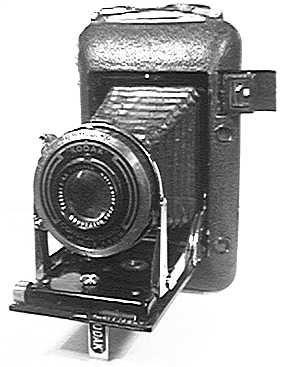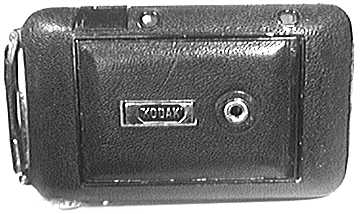|
|
 |
| K o d a k R e g e n t |
Kodak Regent
A German-made stylish dual-format coupled-rangefinder camera presenting a very streamlined appearance when closed. This example has a 10.5cm f/4.5 Zeiss Tessar in a Compur-Rapid shutter with speeds of 1-1/400sec. Focussing is achieved by the knurled knob on the front of the baseboard.
The following information is Copyright © 2005-2007 Kirk Kekatos
reproduced with permission
The "Prince of Kodaks" as a contemporary British advertisement by Kodak Ltd., declared! This product from the Eastman Kodak Company subsidiary, Kodak A.G. Dr. Nagel-Werk Stuttgart, Germany, made for use with the recently introduced Kodak Film No. 620, perhaps best epitomized in cameras, the new "streamline" vogue of the 1930s. An improvement of the 120 film size spool by a new thinner ‘620’ all metal spool, providing a raison d’etre for slimmer camera designs, brought forth this unique folding bellows type camera. Aside of its "moderne vue", one of its operating features was a dual picture format capability to provide eight 2¼" x 3¼" images, or with the supplied film aperture masks, sixteen 1¾"x 2¼" negatives. Another attribute was its wholly integrated coupled range finder.
It was constructed of steel and aluminum with a leather covered bellows, the body trimmed in black enamel with polished chrome-plated fittings and covered in black Morocco leather. It was available with 10.5cm f:3.8 or f:4.5 Schneider Xenar or 10.5cm f:4.5 Zeiss Tessar lenses mounted in Compur or Compur-Rapid shutters with speeds to 1/250 sec. and 1/400 sec. respectively. It incorporated a coupled, coincident image type range finder of 65mm base line, and a folding optical viewfinder with an integral adjustment for the dual format picture option. The range finder and folded viewfinder were completely encompassed within the curved body contours with the retractable film wind knob and adjacent camera front release button barely noticeable with the camera closed.
With the spring-loaded, self-erecting camera front open, a retractable knob placed at the right side of the dropped camera baseboard accomplished the lens focusing with readable distance scale engraved at the baseboard front edge. The shutter release incorporated an extension lever from the shutter’s normal side release position to an upper location of the shutter, thereby providing alternate shutter controls for vertical and horizontal camera handholds. The camera was topped at its carrying end with a leather hand strap carried on metal stirrups situated at the camera back’s sliding latch assembly. The usual camera support strut at the outside of the camera door was present with KODAK embossed in quotation marks, reflecting perhaps the ‘made up’ word. The shutter cover plate bore a faint ‘art deco’ flavor while the lens/shutter assembly support struts and rails reflected a streamlining design effort. As was customary in European cameras, a 3/8" tripod socket with screw-in cover was provided at the camera door center. Weighing in at two pounds with film loaded, this 9.5cm (3 ¾") wide, 16.5cm (6 ½") long and 3.5cm (1 3/8") thick exercise in camera design certainly brought its owner into a new age, until the calamity of World War II arrived.
A handsomely executed brown leather, plush lined pouch type case with hand strap, and "Kodak Regent" embossed on the front flap was available for the camera. The obligatory instruction manual in German was issued and O.E.M. English and French language versions were also published and perhaps in Italian. The Kodak Regent was not imported for U.S. sales by Eastman Kodak Company and is therefore not often encountered here by American collectors. During its time of production, the German prices for the several Regent models were from 135 to 162 Reichsmarks. Kodak Ltd. advertisements in 1936 cited 20 British Pounds for the Tessar/Compur-Rapid version, leather case included - a $100 value at that time and almost $1,400 in today’s Dollars. A 1936 advertisement by Kodak S.A. Milano appearing in the magazine LA VIE D’ITALIA, praised the Kodak Regent, "L’Apparecchio Dell‘Armonia, Della Distinzione" describing the camera’s features equipped with Schneider-Xenar lenses but omitting a price! Kodak AG records indicate that some 10,000 units were produced together with the successor Kodak Regent II camera of 1939.
© 2005-2007 Kirk Kekatos - Chicago Photographic Collectors Society
| name | : Kodak Regent | | produced between | : 1935 - 1939 | | lens | : Various | | shutter | : Various | | film type | : 620 | | picture size | : 6x4.5cm or 6x9cm | | quantity made | : approx. 10,000 | | categories | : folding, 620 |
|
 |
 |
|

